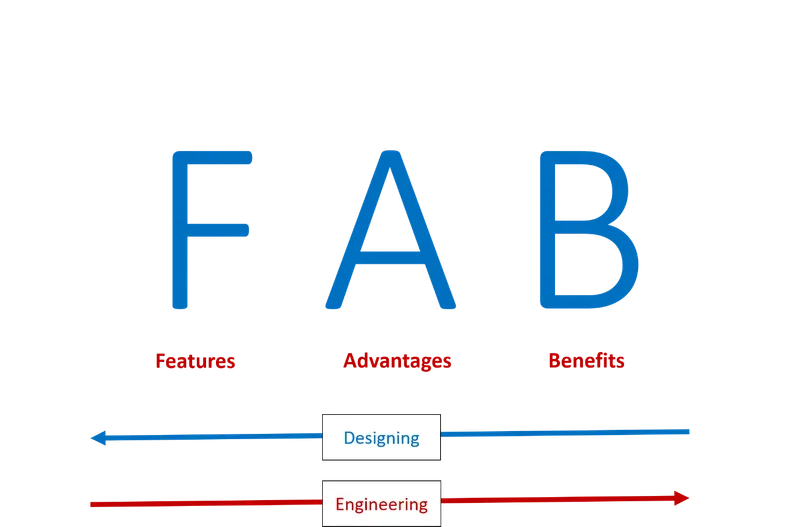A FAB model of new product development
The author dwells on the features, advantages and benefits that separate a great product from one not-so-good. Sometimes a surfeit of features can be a turn-off; instead, the focus should be on ease-of-use, relevance and benefits.
Do you remember the VCR or the VCP remote of the 1990s? Most of us have endured those complex remote controls with no less than 40 buttons on it – buttons for all conceivable scenarios and offering all plausible features. And then there used to be another set of equally arcane buttons on the VCR player, often hidden from plane sight and rarely used.
Those were good examples of bad design. Designed by engineers who didn’t want to let go an inch of silica to waste and driven by the philosophy of ‘just in case’ (the customer wants to watch a movie from a precisely timed frame in the middle of the night). Now contrast this with the remote of Amazon Fire TV Stick. It has the bare minimum buttons, but enough to complement your intuition.
What we have witnessed is a design revolution over the years, where minimalism has taken the place of possibilities and this calls for honing specific mindsets. But that’s not a widely experienced revolution either, as the new product success rates have not gone up and we still see a lot of badly designed products and services offering us suboptimal experiences.
For instance, you still dread going to a bank in person, or picking your baggage at the airports (though the last one seems like a distant past).
In this article, I offer a practical model of thinking about new product development (read new concept commercialisation) which draws from the rich and growing literature of design thinking and lean thinking. The model is dubbed as FAB, which stands for features, advantages, and benefits. The features refer to ‘what all the product is capable of’, advantages indicate the ‘competitive superiority of the offering as compared to the alternates available with the customer’ and the benefits comprise the ‘value-adds that the specific customer derives out of your offering’. Let’s delve deeper into the model to draw some practical insights.

Think benefits and not features
If we go back to the example of the VCR/VCP remotes, those were feature-rich and almost technological marvels, but not every feature translated into a benefit. In fact, most of the customers were left confused. They had to pay for the features that didn’t have any apparent benefit and worse still, they were supposed to use those features.
There was almost an arms race between various VCR makers on who packs more features, which ultimately escalates the cost, complexity, and service issues, not to mention the parts availability and skill requirements of the technicians.
Think of an everyday example – your mobile phone. How many features of your typical smartphone do you use? Maybe, 10-20 percent, on the higher side. Even the most tech-savvy of us can’t claim to use more than 50 percent of what we have, and yet how many features do you pay for? A whole 100 percent. Hence, you buy the whole and use only one fifth of it, and the story goes on with almost all other stuffs of modern-day consumption. Did you ever try to reason out with a seller on pay-what-you-use for a product, or better still convey your frustrations to the designers and manufacturers? It mostly seems futile, because more features intuitively translate into more benefits, akin to saying that ‘more money makes you happier’, which is only true to a certain extent.
All what the customer cares about is benefits, and that too in the context on her specific usage. Harvard’s Clayton Christensen dubs this as ‘job to be done’ principle, where a customer hires your goods or services as a means to an end, which is the job to be accomplished, and if your product does a fine job she would continue to hire you or else she would fire you.
What you need to remember is that while features are generic, benefits are almost always specific, much like the way no two mobile phone screens have identical layouts of icons and apps. So, instead of asking yourself what all features you can pack, start by investigating the benefits the customer is seeking and then work backwards.
The buyer is not as aware of advantages as you may think
Another misconception around product design and development is that a product must be superior to those available in the marketplace, on almost all the dimensions.
Competitive superiority which comes from a pursuit of sustainable competitive advantage often drive a company into over-engineering the product whereby making it costly, complex to use and serve, and paradoxically competitive inferior.
Think of how Amazon Kindle, one with far less features than most tablets, became the quintessential e-book reader, for it was designed for a single purpose in mind – reading e-books conveniently. Or for that matter the remarkable success Honda Activa has enjoyed in India on the backing of its convenience, rather than mileage or styling, which were critical-to-compete parameters for the two-wheelers market in India.
Let’s perform a thought experiment: You get to buy your first car, a sedan. Even with all what you have read on the Internet, at various automobile websites, auto magazines, and reviews at blogs, who’s more knowledgeable about the car, especially how various cars in a segment perform – you or the salesman (or saleswoman)? I guess sellers are far more acutely aware of the car makes, the stats than you, after all they do it for a living.
Similarly, when you are on the other side – a product designer or an engineer – aren’t you more conscious about how your concept fares against others available in the market than your customer is? Affirmative. And hence advantage is only as useful as the benefits desirable by that one specific customer.
There’s no need to impress upon advantages, for these are always relative to the needs at hand, which are often difficult to articulate. Can you claim that a Royal Enfield Bullet has more advantages than a Honda Activa, or a Hero Splendor? That’s not a legitimate comparison unless you ask – for whom are we seeking the advantage? Which again boils down to benefits. Any feature that doesn’t offer a clear and compelling benefit, just drop it. Much like what Stephen King reminds us about writing well: “Kill your darlings, kill your darlings, even when it breaks your egocentric little scribbler's heart, kill your darlings.” It doesn’t matter what you can do, what matters is what adds value to the customer, everything else is a clear waste.
ALSO READ

When designing think benefits backward
The above discussion brings us to the key principle of designing and delivering great products – when designing think benefits backward and when engineering think feature forward. What this phrase essentially translates into is that be very careful about mapping all your features to well identified benefits that the customer would realise and most likely appreciate.
Some such benefits would be articulated and yet others would be not so much and hence offer you avenues to differentiate and secure customer loyalty. Apple has been a master of that and so is Amazon which has been inventing on behalf of the customers, and is reflected by its over 12 percent of R&D intensity (R&D spend as a share of total revenues).
If the starting point of design is benefits, the pertinent question then is – how do we get to know all the benefits sought, especially when the customer herself is not aware of what she needs? That’s a legitimate question and has some useful answers too. IDEO’s Tim Brown laments that often customers do not have the right or rich vocabulary to articulate what they need, let alone desire. Think of how difficult it would be for you to make suggestions to Royal Enfield on what else can go into its super bikes.
However, if you develop the skills of listening with intent, observing with purpose, and willing to defer your judgement you can surprise you and your customer by unearthing the latent and capturing the unstated.
Design thinking, with it crafts of ethnography, Unfocus groups, fly-on-the wall observation techniques, appreciative inquiry, empathy maps, and the likes can offer useful insights. The key is to notice what your customers do and not what they are supposed to do, and thereby drawing new patterns.
The rewards of this effort would then offer you the advantage, your offering the stickiness, and your customers the rationale of continuing with you, at least temporarily. And now when you engineer the product (a shorthand for an offering) consciously map each feature, technological or otherwise, to a clear benefit, stated or unstated, current or future, and go no further.
In summary, the FAB model is a useful starting point for structuring your thinking about new product design and development. It offers the discipline that would restrain you from slipping into flight of fancy which often lead to feature or technology creep, which eventually serves nobody. Remember, you don’t have to be latest or best, you just have to be relevant. That’s how you design FABulous solutions.
(Disclaimer: The views and opinions expressed in this article are those of the author and do not necessarily reflect the views of YourStory.)








